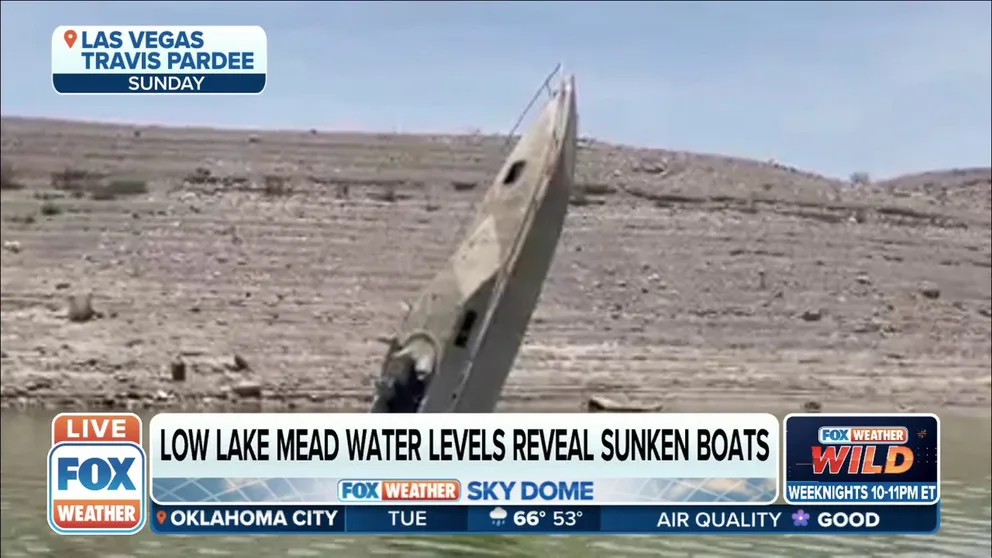How the megadrought exposed dangers of distant volcanoes
As Lake Mead hit record low levels, scientists found volcanic ash in the rock usually underwater. That put up a warning flag to cities hundreds of miles away from volcanos.
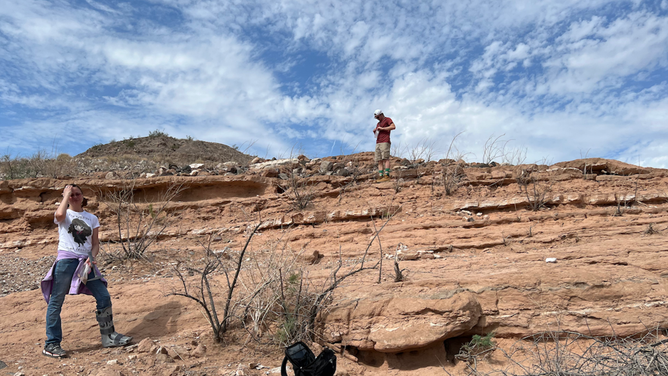
Photo of ash layers near boat ramp to what used to be Las Vegas Bay. The Ash is a thin layer of light colored-material within the beige/orange rock layer. Researcher Racheal Johnsen is in the foreground and research assistant Andrew Litto is in the background.
(Racheal Johnsen & Eugene Smith/UNLV / FOX Weather)
Visitors to the Las Vegas Valley know that the only nearby volcano is at The Mirage hotel, so why did University of Nevada researchers find volcanic ash recently in Lake Mead? The ongoing-drought caused record-low water levels in the country's largest reservoir, which uncovered rock embedded with volcanic ash from distant volcanoes.
"For the western US, there were two large eruptions in the last million years, just yesterday for geologists, that deposited ash over most of the western part of North America," Vulcanologist Eugene Smith said. "If another eruption of this magnitude were to occur again, most of the western US would be affected."
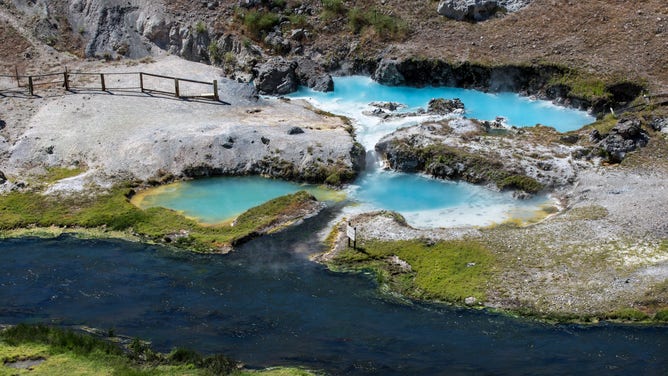
A scalding hot pool of mineral water is viewed along Hot Creek at the Long Valley caldera in Central California near Mammoth Mountain, California. The hot springs, earthquake activity and forest-killing gas releases are evidence of the volcano and keep geologists concerned about another eruption.
( George Rose / Getty Images)
Smith referenced eruptions in Yellowstone and the Sierras in Central California as potentially being sources, if events were large in scale.
"Although the Las Vegas Valley is currently very far away from any active volcanoes, we can and will have ash from these volcanoes fall over Southern Nevada in the future," Smith said in a news release. "Even a couple of millimeters of ash, when wet, is incredibly heavy and can take down power and telecommunications lines. It can block roadways. It is easily remobilized by wind and water. When inhaled, the incredibly tiny but sharp glass grains in the ash can cause significant, chronic lung conditions such as silicosis."
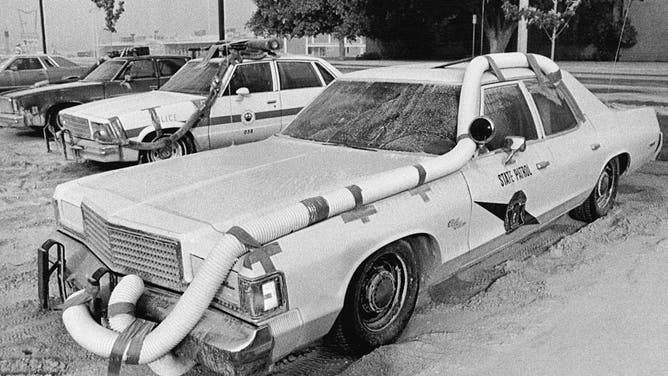
Washington State Police engineered devices to prevent volcanic ash from entering the engine during the Mount St. Helen's eruption.
(Bettmann / Getty Images)
Smith believes even small amounts of ash can threaten air travel and would probably shut down airports. Cars and trucks can even become immobilized causing transportation to come to a halt.
Smith authored a study with geologist Racheal Johnson and described the dangers of volcanoes even for distant cities. They tested the ash that has not seen the sun since 1935 when the government built the Hoover Dam on the Colorado River and flooded the reservoir.
HOW TO WATCH FOX WEATHER ON TV

Usually underwater, layers of rock with volcanic ash becomes available to scientists to study,
(Racheal Johnsen & Eugene Smith/UNLV / FOX Weather)
Smith said that current volcano emergency planning revolves around areas in the immediate area of a volcano and the path of lava. He hopes local government officials develop a plan of action similar to plans dealing with flood, earthquakes and tsunamis.
"It is important that metropolitan areas like Las Vegas, Salt Lake City, and Phoenix realize that the volcanic hazard may be more related to distant volcanoes rather than to local volcanic eruptions," Smith said. "Just because there aren't any local volcanoes with a high potential for eruption doesn't mean that there is no volcanic hazard."
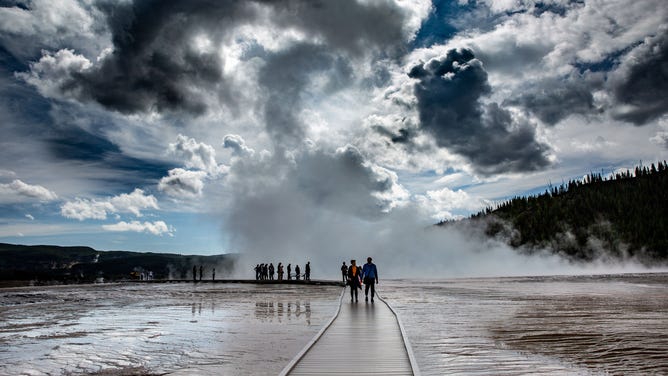
Visitors walk along a boardwalk at the iconic Grand Prismatic Spring in Yellowstone National Park. The geyser sits atop an active volcano caldera.
(George Rose / Getty Images)
Experts said communities along the Cascade Range should also be well-prepared for an eruption.
Smith points to the 1980 eruption of Mount St. Helens. He called it a geologically small eruption. Even so, it produced a cloud of ash that traveled as far as the Great Lakes. Idaho and Montana suffered infrastructure problems along with Washington.
MOUNT ST. HELENS' ERUPTION: SURVIVORS RECOUNT THE ‘DARKER THAN MIDNIGHT’ FURY IN 1980
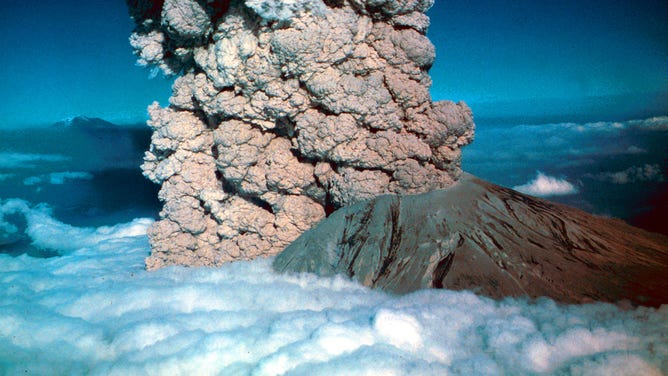
Mount St. Helens erupting in 1980 in Washington.
(Photo12/Universal Images Group / Getty Images)
Without a megadrought, discoveries likely wouldn't have happened
The volcanic material is the latest of a long list of discoveries made due to the falling water level of Lake Mead during the West’s megadrought.
Police added evidence to a cold case when someone found a barrel containing a murdered corpse that the perpetrator felt would stay hidden beneath the waves for eternity. The shrinking lake is also an obstacle course for boaters as the boats in the underwater graveyard now tower over the surface.
ONGOING 22-YEAR DROUGHT IN WESTERN US IS DRIEST PERIOD IN OVER 1,200 YEARS, STUDY FINDS
Low Lake Mead water levels reveal once sunken boats
Travis Pardee took video and photographs of several of the boats, including one that somehow surfaced in a vertical position.
This year, Lake Mead hit record low levels over the summer and is only a few feet higher right now. It is 184 feet below full pool which is only a quarter of its capacity, according to the Bureau of Reclamation.
ROBBING LAKE MEAD OF WATER: THE EMERGENCY PLAN AIMED AT KEEPING WATER FLOWING TO THE WEST
